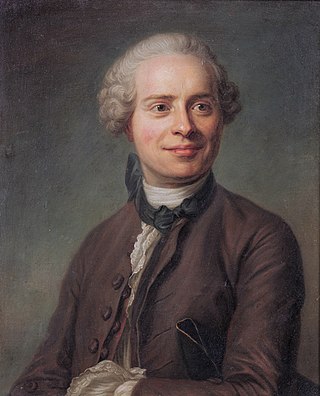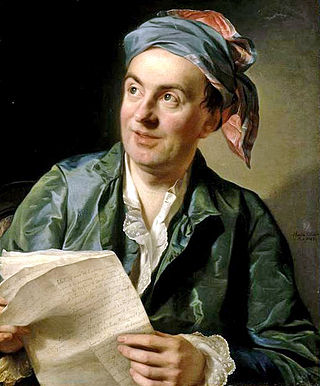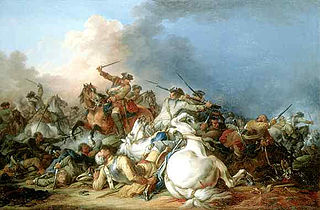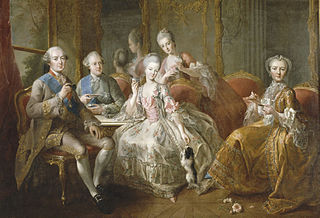
Denis Diderot was a French philosopher, art critic, and writer, best known for serving as co-founder, chief editor, and contributor to the Encyclopédie along with Jean le Rond d'Alembert. He was a prominent figure during the Age of Enlightenment.

Jean-Baptiste le Rond d'Alembert was a French mathematician, mechanician, physicist, philosopher, and music theorist. Until 1759 he was, together with Denis Diderot, a co-editor of the Encyclopédie. D'Alembert's formula for obtaining solutions to the wave equation is named after him. The wave equation is sometimes referred to as d'Alembert's equation, and the fundamental theorem of algebra is named after d'Alembert in French.

Paul-Henri Thiry, Baron d'Holbach, known as d'Holbach, was a Franco-German philosopher, encyclopedist and writer, who was a prominent figure in the French Enlightenment. He was born Paul Heinrich Dietrich in Edesheim, near Landau in the Rhenish Palatinate, but lived and worked mainly in Paris, where he kept a salon. He helped in the dissemination of "Protestant and especially German thought", particularly in the field of the sciences, but was best known for his atheism, and for his voluminous writings against religion, the most famous of them being The System of Nature (1770) and The Universal Morality (1776).

Jean-François Marmontel was a French historian, writer and a member of the Encyclopédistes movement.

Jean-Baptiste Greuze was a French painter of portraits, genre scenes, and history painting.

Pierre-Jean Mariette was a collector of and dealer in old master prints, a renowned connoisseur, especially of prints and drawings, and a chronicler of the careers of French Italian and Flemish artists. He was born and died in Paris, and was a central figure in the artistic culture of the city for decades.

Jean-Michel Moreau, also called Moreau le Jeune, was a French draughtsman, illustrator and engraver.

Claude-Henri Watelet was a rich French fermier-général who was an amateur painter, a well-respected etcher, a writer on the arts and a connoisseur of gardens. Watelet's inherited privilege of farming taxes in the Orléanais left him free to pursue his avocations, art and literature and gardens. His Essai sur les jardins, 1774, firmly founded on English ideas expressed by Thomas Whately, introduced the English landscape garden to France, as the jardin Anglois. The sociable Watelet, who was born and died in Paris, was at the center of the French art world of his time.

Francesco Giuseppe Casanova was an Italian painter who specialised in battle scenes. His older brother was Giacomo Casanova, the famous adventurer, and his younger brother was Giovanni Casanova; also a well-known painter.

Jacques-Henri Sablet was a Swiss-French painter, part of a family of artists of Swiss origin. He was also known as Franz der Römer, Giacomo Sablez, Giacomo Sablé, Jacob Henry Sablet, Sablet le Jeune, Sablet le Romain or le peintre du Soleil.
Jean-Baptiste Cyprien d'Huez was a French sculptor.

The Village Bride is a painting by the French artist Jean-Baptiste Greuze, created in 1761. It is now in the Louvre, in Paris. The work was first exhibited at the Salon of 1761, where it was unanimously praised by the critics, notably by Diderot. It was the first example of the 'moral painting' genre, to which Greuze often returned.

The Laundress is a 1761 genre painting by French artist Jean-Baptiste Greuze (1725–1805), existing in two versions. The subject of laundresses, also known as washerwomen, was a popular one in art, especially in France.

Pierre-Jacques Willermoz was an 18th-century French physician and chemist.
Adrien Quiret de Margency also Adrien Cuyret de Margency was an 18th-century French officer of the Maison militaire du roi de France, writer and Encyclopédiste.

The Lady of Charity is a 1773 oil-on-canvas painting by Jean-Baptiste Greuze, now in the Museum of Fine Arts of Lyon. It shows a wealthy lady encouraging her young daughter to give alms to a dying old man.

Jean-Baptiste Charpentier the Elder was a French Rococo portrait painter, associated with the Royal Court. He is best known for portraits of Marie-Antoinette and Louis Jean Marie de Bourbon, Duke of Penthièvre. He also painted members of the Duke's family. His early works were mostly genre scenes.

François Hippolyte Walferdin was a French politician, physicist, art collector, editor, and writer.

The Bible Reading, Reading the Bible or The Father of a Family Reading the Bible to his Children is a 1755 oil on canvas genre painting by Jean-Baptiste Greuze. It was exhibited at the Académie royale on 28 June 1755 then at the Paris Salon on 25 August the same year. It was declared a national treasure of France in 2012 and has been in the Louvre since 2016.

The Salon of 1761 was an art exhibition held at the Louvre in Paris. Staged during the reign of Louis XV and at a time when the Seven Years War against Britain and Prussia. was at its height, it reflected the taste of the Ancien régime during the mid-eighteenth century. The biannual Salon was organised by the Académie Royale. Jean Siméon Chardin was in charge of choosing hanging locations for the two hundred or so works on display. A number of submissions were Rococo in style. The art critic Denis Diderot wrote extensively about the Salon.

















